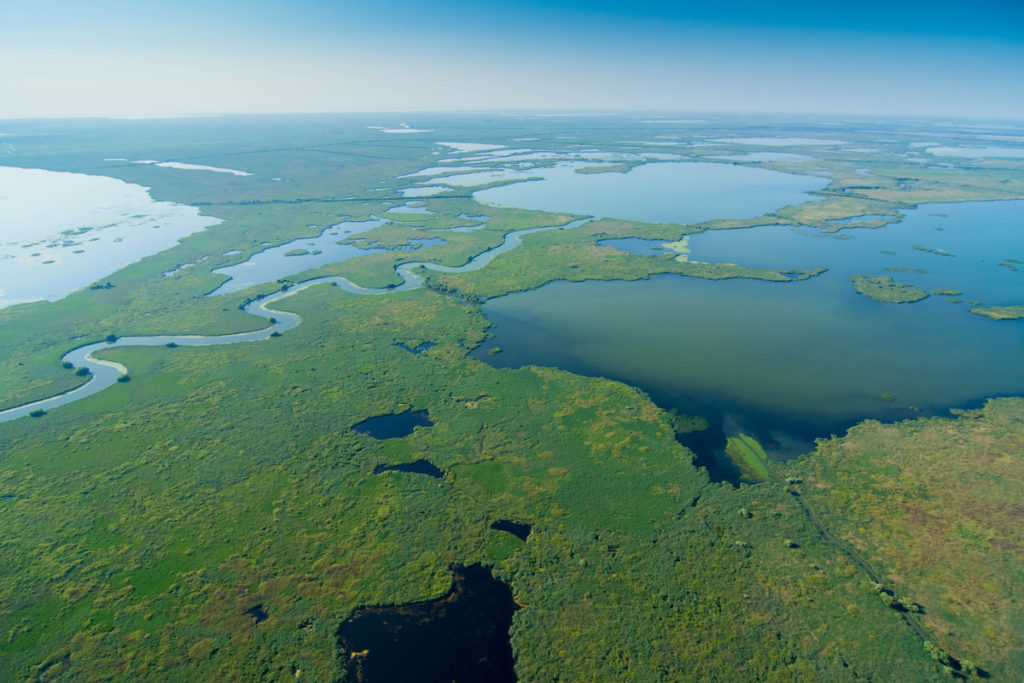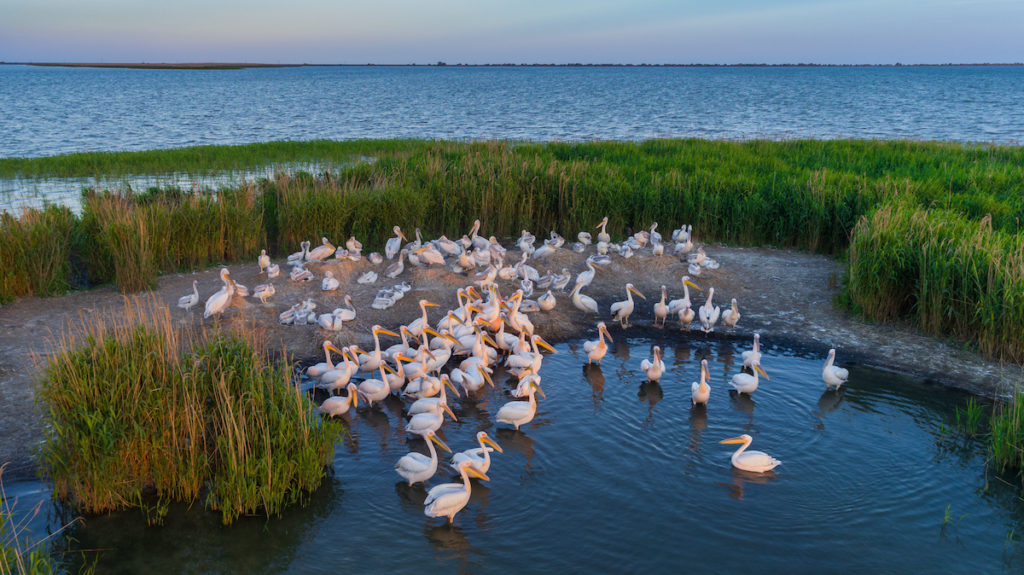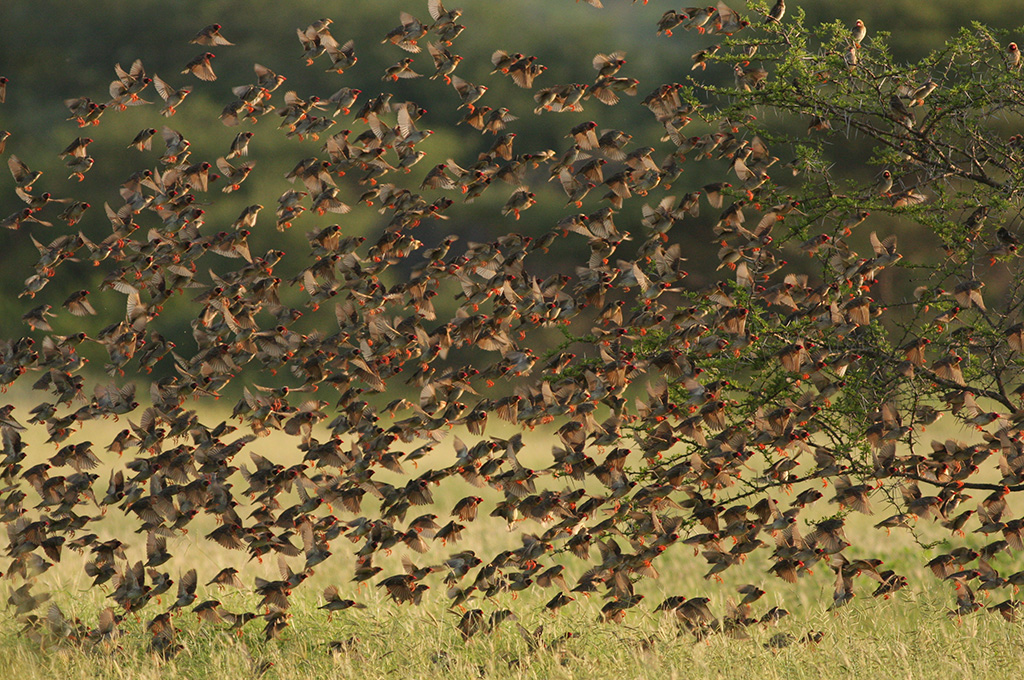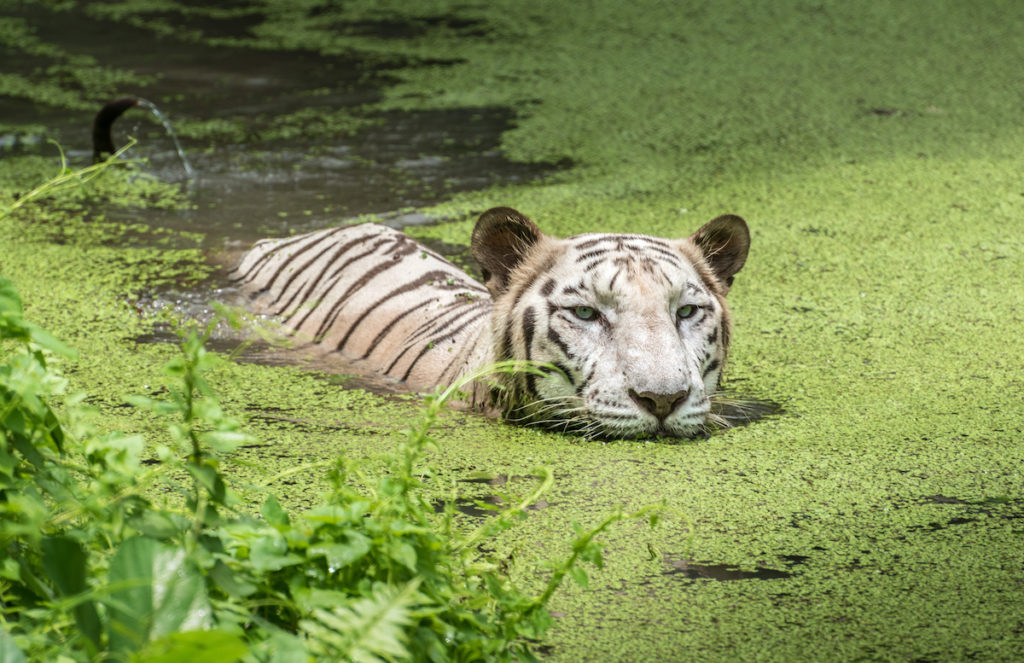Wetlands occur naturally throughout the world (except in Antarctica), and are considered the most biologically diverse of all ecosystems. They provide habitat for a great number of water and land species, and are an important environment to many migratory bird species. Types of wetlands include swamps, bogs, marshes and estuaries – here are some of the most spectacular.
The Okavango Delta
Covering some 16,000km2, this wetland in Botswana is one of the world’s great inland waterways and is Africa’s largest and most beautiful oasis. It is formed where the Okavango River empties over the sands of the Kalahari Desert, where most of the water is lost to evaporation and transpiration instead of draining into the sea. The massive watering hole of fresh water is home to startlingly green reed beds overhung by towering trees and brings in huge numbers and varieties of wildlife.


Visiting species include elephant, hippopotamus, giraffe, wildebeest, crocodile, lion, cheetah, rhinoceros and zebra. The majority of the estimated 200,000 large mammals in and around the delta are not year round residents. They leave at the time of the summer rains and then make their way back as winter approaches, so the best time to visit is between July and October.
Botswana’s lodges and camps arrange dugout canoe (mokoro) trips through the maze of channels, while the more active could take a riding safari and experience the exhilaration of galloping alongside herds of zebra and antelope.
The Pantanal
This is the world’s largest and best-preserved freshwater wetland of any kind, lying mostly in western Brazil but also extending into Bolivia and Paraguay. Covering 230,000km2 – more than half the size of France – only part of the Pantanal is a national park. It is made up of a complex system of marshlands, floodplains, lagoons and interconnected drainage lines.


Unlike many other biologically intense areas, in the Pantanal you are virtually guaranteed to see wildlife. It is home to over 658 species of birds, 190 mammals, 50 reptiles, 270 species of fish and an amazing 1,132 species of butterflies. Capybara and the yacare caiman are present in the millions. The Pantanal is also the best place in all of the Americas to spot a jaguar in the wild, given the relatively small amount of thick rainforest cover, especially in the dry season (May–Oct).
Danube Delta
The mighty River Danube flows 1,788 miles from its springs in Germany’s Black Forest out into the Black Sea on the Romanian coast. Just before reaching the sea, it forms one of Europe’s largest, best-preserved and arguably most beautiful deltas. With huge reed beds (the largest single expanse in the world), lakes, waterways, tree-fringed lakes and marshes, the Danube Delta is home, or a stopover, for more than 300 species of birds and 45 fish species.


The best way to experience the delta is by boat, whether on a passenger ferry, an organised excursion, or by hiring your own canoe – all available from the delta’s main town, Tulcea, which also has good hotels and restaurants. Although very hot in summer, it is a year-round destination. The best months for birdwatching are mid April to mid May and October to November.
Kafue Flats
Covering some 6,500km2, the flats of Kafue National Park provide a unique wetland landscape of grasslands, lagoons, marshes, swamps, reed beds and seasonally inundated floodplain, flooded to a depth of less than a metre in the rainy season and drying out to a black clay in the dry season.
It is one of the major wetlands in water-rich Zambia and is extremely important for wildlife, fishing, cattle-grazing, sugar-cane farming and the production of hydro-electric power.


The Kafue lechwe, an antelope specialised for living in the marshy conditions of the flats, is endemic to the area. It used to occur in enormous numbers, with population estimates in the 1930s suggesting about 250,000 animals living across the whole Kafue Flats area, but by 2005 the numbers had fallen to 38,000, mainly attributable to the building of the Itezhi-Tezhi Dam, subsequent changes to the flooding pattern plus poaching. Zebras are the other main species of large mammal to be found in the area along with wildebeest, buffalo, roan antelopes, kudus and hippos.
The Sudd
Almost half the waters of Africa’s mightiest river, the White Nile, are lost into South Sudan’s swamps, the largest of which – the Sudd – covers 15% of the country’s total land area. Also known as the Bahr al Jabal (mysteriously meaning ‘Sea of the Mountain’ in Arabic), the Sudd stretches from Mongalla to just outside the Sobat confluence with the White Nile just upstream of Malakal as well as westwards along the Bahr el Ghazal.

Its size is highly variable, averaging over 30,000km2 (approximately the size of England) in the dry season, while during the wet season it might extend to over 130,000km2, depending on the amount of inflowing waters coming from Lake Victoria. It is a vast expanse of swampy lowland and consists of various meandering channels, lagoons and reed and papyrus beds.
Dinka, Nuer and Shilluk pastoralists use the Sudd and the surrounding areas extensively. Livestock and rain-fed agriculture are the dominant means of support for the largely rural population for which the seasonal flooded grasslands along the Sudd provides valuable grazing lands.
The Sundarbans
The 10,000km2 pristine and abundant wilderness of these wetlands is the largest littoral mangrove forest in the world spreading across southern Bangladesh and into West Bengal in India. The name ‘Sundarban’ can be literally translated as ‘beautiful forests’ in Bengali, but the region might also have been named after the large number of Sundari trees that grow in the area. Approximately a quarter of the wilderness is water.


Several predators dwell in this unique habitat, including the planet’s biggest Bengal tiger population, possibly in the region of 400 to 500 animals. Unlike in other habitats, here tigers live and swim among the mangrove islands, where they hunt prey such as spotted deer and wild boar.
Birds abound in the nutrient-rich ecosystem of the Sundarban Forest, especially during the winter months when migratory species join the residents. Look out for nine species of colourful kingfishers, several varieties of woodpeckers, egrets and, if you are lucky, the masked finfoot.
WWT Caerlaverock
This wetland reserve is one of the absolute highlights of Dumfries and Galloway, if not all of Scotland. If you have an ounce of interest in wildlife, or simply in being outdoors in a beautiful place, you could easily lose yourself for a day – or longer – here.
In summer the Senegalese flag flies as Senegal is where the Caerlaverock ospreys spend the winter. In winter it’s the Norwegian flag (amongst others), for it is to Caerlaverock each year that the entire population – all 35,000 of them – of barnacle geese returns from Svalbard, around 10,000 of which are usually to be found in the WWT reserve.
Kopački Rit
Situated in northeast Croatia, this is one of Europe’s most important wetlands, caused by the confluence of the Drava and the Danube. As a result, it’s a birdwatcher’s paradise, with around 140 species nesting here, and some 285 species recorded (birds, not birdwatchers). Among the nesting species are geese, grey, white and purple herons, egrets, coots, kingfishers, woodpeckers and storks.

There’s also the endangered ferruginous duck, several pairs of rare black storks, and a number of white-tailed sea eagles, as well as a cormorant colony. During the spring and autumn migrations, the park is used as a layover by hundreds of thousands of birds, so that’s the best time to come, but in summer it’s still a wonderful place, even for the most lackadaisical of ornithologists.
Mesopotamia Marshes
Located in southern Iraq and partially in southwestern Iran and Kuwait, the Mesopotamia Marshes are considered to be the site of the Garden of Eden. Sadly, however, Saddam Hussein drained these unique wetlands in the 1990s as a punishment to the region’s Marsh Arabs, who had backed an uprising. These millennia-old wetlands were on the verge of disappearing, having been reduced to one tenth of their original size.
Nowadays though, thanks to many years of effort, the Mesopotamian Marshes are slowly recovering and have been sufficiently restored – they were designated as Iraq’s first national park in 2013 and as a UNESCO World Heritage Site in 2016. Fed by the mighty Tigris and Euphrates rivers, the marshes were once the largest and richest in wildlife in the Middle East. At approximately 7,700 square miles, the marshes are the third most extensive in the world.
The Marsh Arabs are the primary inhabitants of the Mesopotamian Marshes and are the descendants of ancient Sumerians. Some 90,000 of them have returned to live in their native marshland, having been scattered during Saddam’s oppressive regime. They live in reed houses in secluded villages throughout the marshes, often only accessible by boat. Fish, rice cultivation, water buffalo and other resources are also used in their daily lives. The marshes are now home to over 70 species of bird and several species of fish, with the Basra reed warbler and Iraq babbler finally having returned to the area.
Marais Poitevin
The second-largest wetland in France – after the Camargue – the Marais Poitevin is made up of three elements: a narrow coastal strip; a huge expanse of open fenland or ‘dry marshes;’ and a captivating area of ‘wet marshland’ bearing the name of La Venise Verte, or ‘Green Venice’.

On the coast, La Tranche-sur-Mer boasts some of the regions best beaches and is a popular holiday destination. Inland, nearly 50,000ha of land reclaimed from the sea constitute the dry marshes, by far the biggest part of the Marais Poitevin Natural Park.
The flagship feature of this southern part of the Vendée, however, is the area known as the Venise Verte, or ‘Green Venice’. This carefully preserved green and leafy part of the southern marshlands is full of picturesque villages and numerous canals and cycleways. Here, you can travel by boat or bike among a maze of tranquil, tree-shaded waterways – a wonderful antidote to the frenzy of everyday life.
More information
Discover more in our comprehensive guides. And find out the difference between a swamp and a bayou here.